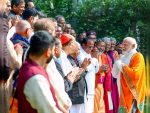By F M Britto
Raipur, Sept 14, 2022: A national convention has tried to unite tribals from various parts of India.
The convention at Raipur, Chhattisgarh, marked the International Tribal Rights’ Day that the UN declared on September 14, 2007.
The September 12-13 program gave hundreds of tribal people a platform to express their problems and display their unique cultures.
The Tribal Affairs Office of the Catholic Bishops’ Conference of India (CBCI) was involved in organizing the program, its secretary Divine Word Father Nicholas Barla told Matters India.
Addressing the gathering, Chhattisgarh Governor Anusuiya Uikey, a tribal, expressed solidarity with them. She promised to take up “our” rights, even after relinquishing her post as she had been doing earlier.
Informing the participants that the local Congress-ruled Chhattisgarh state has restored lots of rights to the indigenous people, the governor said, “The tribal rights prescribed in the Constitution should be restored to the tribals in the country.”
Hosting the tribal convention, the state government has provided a lot of facilities, she added.
The Indian Constitution has provided many rights to indigenous people. But many governments do not grant them in practice. The indigenous people fight for their very survival. Due to the influence of western culture, their unique culture is also vanishing.
The international tribals had got organized and expressed their grievances in front of the League of Nations in 1923. It was declared in 2007 that September 13 would be celebrated every year as the International Tribal Rights’ Day.
It was celebrated at Nagpur in 2017, Ranchi in 2018, Mysore in 2019, Gujarat (2020) and Dipu (2021). Every year new office-bearers are elected from various areas to work for their rights and to organize this event.
The governor also said she had been working along with President Droupadi Murmu, when she was the Jharkhand governor in solving the tribal issues. Even after becoming the president, Murmu is interested in tribal welfare, Uikey said and asked the tribal leaders to send her the unresolved issues.
India has about 705 indigenous communities with about 120 million tribals, mostly in the central and northern India, a mineral rich region. But the nature worshipers remain undeveloped despite many government reservations.
Jesuit Father Kalyan Minj, director of St Xavier’s College of Education, Ambikapur, said the convention has helped unite tribals from various parts of India.”It has given them a platform to share their problems and display their unique culture,” he told Matters India.
“The tribal convention has been organized since a few years to mark this date,” said Father Minj, a former Jesuit provincial of the Madhya Pradesh. “It had been previously organized even in more grand style in various parts of our country. But due to the Covid-19 restrictions since a few years it could not be properly organized.”
The tribal priest from Chhattisgarh said the convention has given the tribals a greater awakening. “It is a good move. All the tribals have come under one umbrella.”
Amarjeet Bhagat, a Chhattisgarh minister, demanded the restitution of their constitutional rights to the tribals. The minister of food, civil supplies and culture praised the Chhattisgarh government for granting many rights to the tribals, who have been suppressed in the country.
The tribal minister pointed out that reservation has helped tribals come up in education. “But they have not progressed in employment. For that the powers have to be given to the tribals in the panchayat level (village assemblies).
Bhagat bemoaned that although tribals had fought for the national Independence, the recognition given to them was inadequate.
The convention heard tribal leaders from various regions expressing their problems, rights and ways to solve them. In between the speeches, various tribal groups presented their cultural dances.
A tribal procession was taken on September 13 morning where participants dressed in their cultural costumes and displayed their dances and rights. It began from the convention place, Deen Dayal auditorium of the city’s Science College, to the heart of the state capital city, Jai Stump Chowk, about 6 km long.
The convention began with honoring past tribal heroes such as Birsa Munda, and Durgabati Mata.
The convention ended with the participants pledging allegiance to the Indian Constitution by reciting the Preamble.








